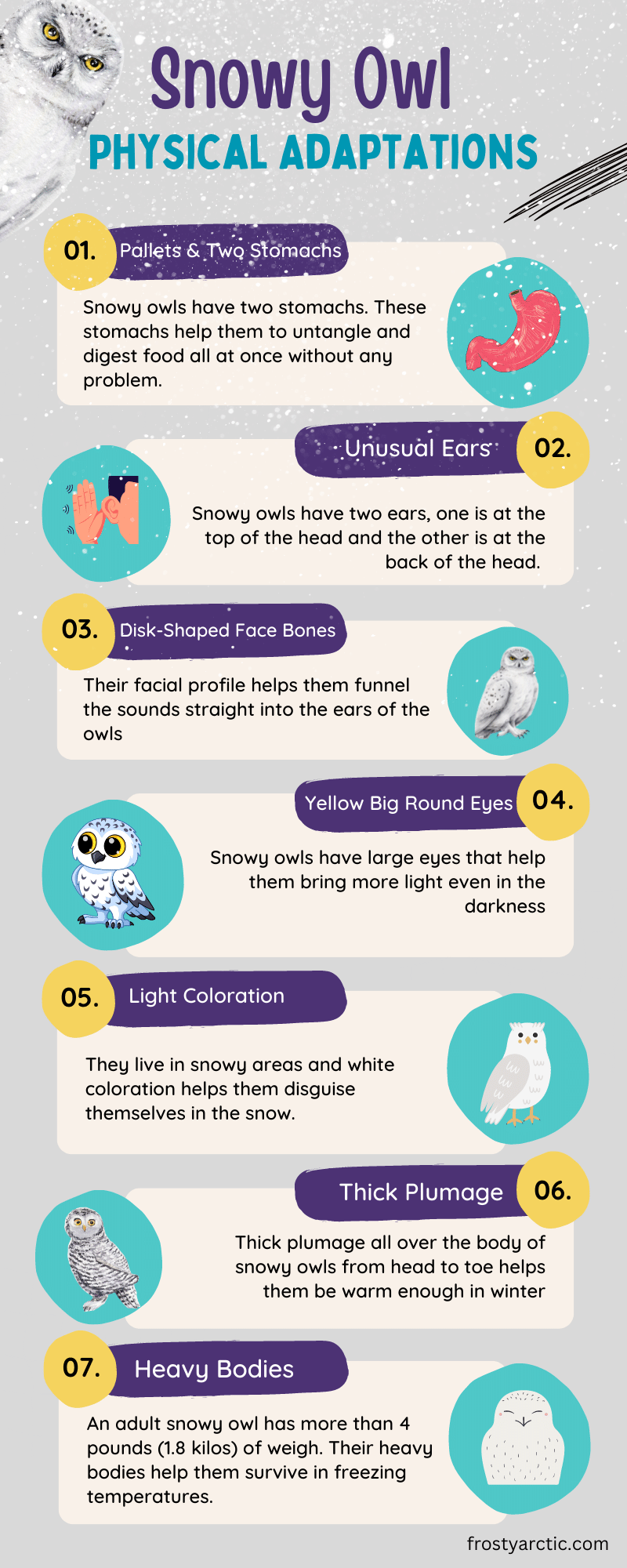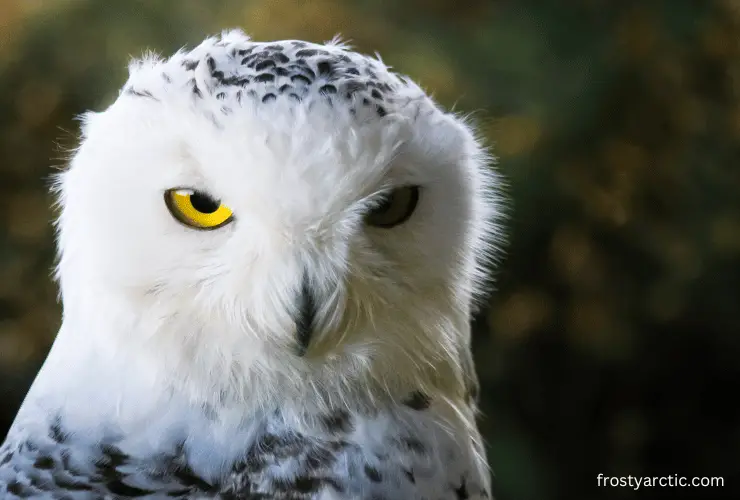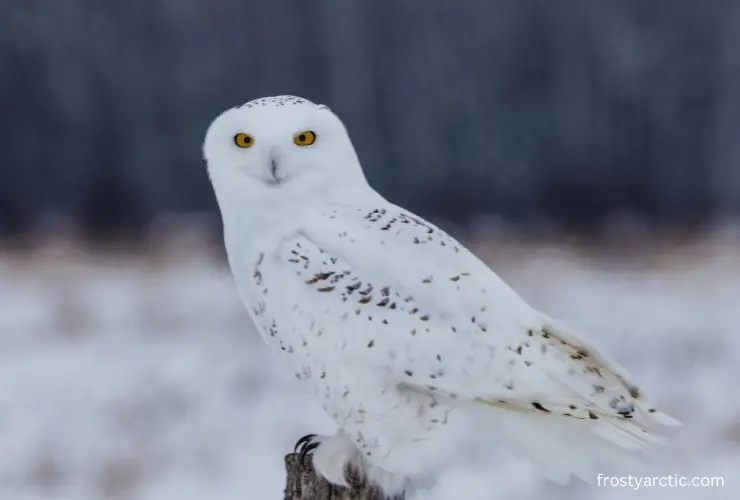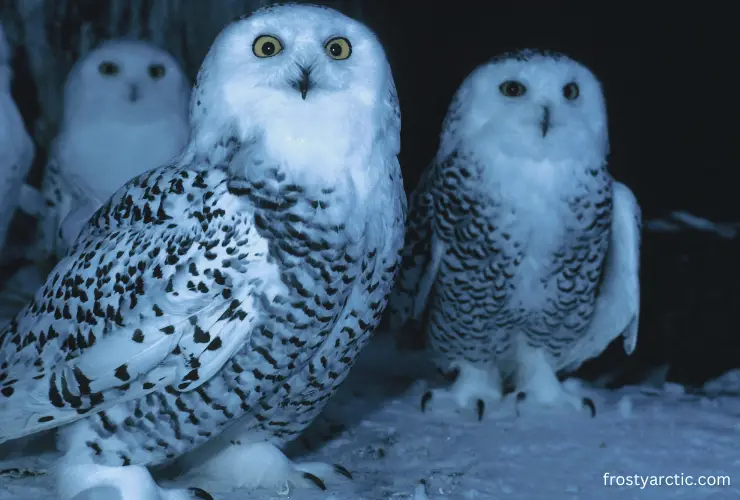Snowy owls have an amazing array of structural, behavioral and physical adaptations that help them survive in harsh Arctic conditions. Their white color serves as camouflage in the snow, and their thick plumage acts as insulation. They aid in hunting with their large, sharp talons and beak. They also have keen hearing and eyesight for spotting prey, even through heavy snow.
The physical adaptations are just the beginning of their incredible story. How can we forget to mention exceptional camouflage behavior? Also, the intriguing abilities of great white owls to survive in the cold temperatures of Tundra provide them with excellent insulation. Additionally, their feathered feet and legs work like natural snowshoes.
Thus, snowy owls possess many adaptations that will blow your mind. These beautiful birds know how to survive, whereas others fail to resist harsh temperatures and bad conditions. But how do these majestic birds brave the bone-chilling arctic weather? Let’s learn all about their adaptations below in detail.
Physical Adaptations of Snowy Owls

Here are a few physical adaptations of snowy owls:
1. Pallets & Two Stomachs
Whenever a snowy owl eats something, the bones and meat of the prey will never get separated like in other birds (for example, hawks). Moreover, snowy owls lack teeth and do not know how to eat with a fork or knife-like humans. So what do they do? How do they eat and how do the bones and meat of their food get separated?
According to the news portal TheCornellLab, snowy owls are accustomed to swallowing their prey in just one gulp. Snowy owls have two stomachs. These stomachs help them to untangle and digest food all at once without any problem. First of all, the whole prey goes into the owl’s stomach.
The first stomach contains digestive fluids that separate food and meat from unwanted and indigestible nutrition items. Indigestible items include feathers, teeth, bones, hair, and nails. Now the remaining food portion (meat and digestible food) goes straight to the second stomach. On the other hand, unwanted elements stay in the stomach.
Now the real work of the first stomach starts up. It squeezes all the remaining or unwanted stuff (indigestible food items) together. This squeezed material is known as a snowy owl pellet. Eventually, the last stage comes when the snowy owl spits out or regurgitates that pellet. Can you find out what the snowy owl eats from its pellet? You most likely found a rodent, like a field mouse or a lemming. ~ Source
2. Unusual Ears
Snowy owls have asymmetrically positioned ears. This is their anatomical transformation, according to a British Trust for Ornithology study. They have two ears, just like humans, on each side of the head. But the similarities stop here.
Snowy owls have two ears, one of which is at the top of the head and the other of which is at the back of the head. Moreover, one of the ears is bigger than the other ear. This biological adaptation helps them to point out or triangulate precisely where the prey’s sounds are coming from.
3. Disk-Shaped Face Bones
The snowy owls’ facial disk helps them listen to everything better. Their facial profile helps them funnel the sounds straight into the ears of the owls. Moreover, disk-shaped face bones work as parabolic reflectors.
They can hunt at night using this technique by listening to sounds. Their facial disk is just like a concave anthology of feathers, mostly encircling the eyes. This face shape works just like a satellite dish that compiles the signals (sounds in this case). ~ Source
4. Yellow Big Round Eyes

Snowy owls have large eyes that help them bring more light even in the darkness. These are the only extraordinary birds that have a binocular vision system. It means their rounded eyes are placed in front of their face. This is how it helps them give depth perception.
Their oversized eyes help them see in three dimensions. They also look cute and innocent with their yellow eyes. Both eyes help them specify their food’s exact spot with a clearer depth perception. This is a terrific adaptation of the tremendous white owl.
5. Light Coloration
The Owls Research Institute claims that snowy owls have entirely white or almost white feathers on their bodies. They live in snowy areas and white coloration helps them disguise themselves in the snow.
It helps them protect their roosts and themselves from predators. Similarly, they hide in white-colored surroundings to take hold of their prey. Thus, this is a win-win adaptation for hiding from predators as well as prey! ~ Source
According to the TheCornellLab report, male snowy owls have a dark brown color when they are immature. When they get older, their color turns fully white. On the other hand, female snowy owls remain white from adulthood until their deaths. ~ Source
6. Thick Plumage
Snowy owls are perfectly adapted to live in the Arctic regions. Thick plumage all over the body of snowy owls from head to toe helps them be warm enough in winter. This physical adaptation keeps them insulated in the tundra.
These thick and lengthy feathers cover their entire legs and toes. Due to their thick plumage, the Arctic winds do not get past their bodies. It also regulates their internal temperature.
7. Heavy Bodies
An adult snowy owl has more than 4 pounds (1.8 kilos) of weight. That’s more than any other great bird. Their heavy bodies help them survive in freezing temperatures.
These biggies do this by conserving a lot of energy in their large bodies. They are included as the heaviest members of their family due to their heavy bodies.
Wait! We are missing one of the physical adaptations of snowy owls. It’s their sharp beaks. Their knife-like beaks help them to wear down the prey smoothly and catch it efficiently with the help of a nib.
Behavioral Adaptations of Snowy Owls

We are anxious to divulge some of the worth mentioning behavioral adaptations of snowy owls:
1. Monogamous Relationships
According to a study by BioKids, snowy owls build monogamous relationships. It means one male mates with or breeds with one and only one female. However, there are some exceptions when two female snowy owls start breeding with one male snowy owl. It happens when plenty of food is available. Furthermore, a pair of snowy owls hunt together, one by one, to feed the chicks.
Male snowy owls amuse and try to seduce female snowy owls in late winter. During the wintering grounds, breeding couples get together with the intention of getting pregnant. They also mate once they arrive at the breeding site in early May or late April. It is likely that snowy owls have a new partner every year, but it is not their usual behavior. ~ Source
2. Solitary and Territorial Behavior
Snowy owls like to live away from the hustle and bustle. They are strictly territorial. They can do anything to safeguard their territories. They use diverse postures and also vocalize when someone tries to pose a threat to their habitat.
The area of the territories of snowy owls depends on the availability of food. Their territories are very small if a lot of prey is available. Also, they only need small areas to hunt for food if prey is easily available everywhere.
3. Unpredictable Migrations
Snowy owls are migratory birds. However, their migrations are unpredictable. They do not migrate like other birds, which do so every year at the same time. What do ordinary birds do during the migratory season? They either migrate towards the south in the fall or north in the spring.
But snowy owls migrate only when food is inadequate. That’s another reason why their migrations are unexpected. Many snowy owls migrate to the south after four or five years. During the winter, they stay in the northern United States. It happens only when their favorite lemmings are unavailable in the northern tundra. ~ Source
According to the All About Birds organization’s report, “Snowy owls have an extraordinary dispersal behavior. Now what does it signify? Snowy owl adults disperse extensively from their motherland. Here is proof: a lone snowy owl nest located on Victoria Island in the Canadian Arctic witnessed the remarkable journeys of its adults.
Notably, one sibling went on a lengthy migration to Hudson Bay. Another sibling ventured toward southeastern Ontario. The third adventurous expedition made its way to the distant reaches of the far eastern Russian coast. These trips show snowy owl adults can spread their presence across far-flung and diverse regions.
4. Perch hunting
According to the study by Quora Digest, snowy owls have perch behavior. It is a common behavior among all snowy owls. They occasionally walk to save energy while catching prey and go for short flights. This behavior demonstrates they stalk from their perch, such as a rocky outcropping or a tree.
Snow owls sit solitary on their perch (a pole, tree, rock, fence) and wait for many hours for the prey to come out of their homes. This behavioral adaptation allows them to conserve their energy and reduce heat loss, particularly in winter. ~ Source
Snowy Owls’ Adaptations as Predators

Snowy owls would be at the top of the list if you look at the most successful and precise hunters in the world of birds. Do you have any idea about the predatory adaptations of snowy owls? What makes them good hunters in the wild?
Snowy owls have some sensory adaptations that make them superior hunters. And today we are going to examine a couple of them below:
1. Silent Flights
Snowy owls flap their feathers while flying, but their flights are silent. This is one of the most engrossing adaptations of snowy owls. Their specially adapted wings can slice through the air without making noise.
The rationale behind silent flights is the comb-like projections in their wings. They are able to fly more quietly thanks to these projections. Now you can easily imagine why snowy owls have silent flights. Why is it beneficial for them?
When snowy owls are about to catch their prey, they dive into the air with silent flights. In this way, the prey is totally unaware of their attacks. As a result, the snowy owl is on the head of their prey and catches it without giving it a chance to escape.
2. Hearing Ability
We are back to hunting snowy owls. It’s also included in the physical adaptations of these Tundra owls. The ears of snowy owls make them extraordinarily smart hunters. They aid them in looking into the locations where the prey is moving and whispering. Snowy owls can easily find and surprise their prey, even if they are hiding under the snow.
We are so excited to share that snowy owls can hear a lemming or a little mouse moving and going in the leaf litter. But how far can the snowy owls hear them? From more than 200 feet away. This is not a joke. Literally, they can hear them from over 200 ft. away!
3. Exceptional Eyesight
Snowy owls suddenly head towards targeted prey after hearing sounds. They start traveling in search of movements while scanning the ground, hoping it’s prey. And did you know that snowy owls have superb vision?
Snowy owls have the interesting ability to look at their favorite lemmings from 100+ feet away. No matter if the lemming moves only one inch, they’ll find their favorite prey. This is how their eyesight helps them find prey just by sitting on a pole and observing the surroundings.
4. Active Day and Night
Snowy owls are active hunters. Although they typically hunt day and night, they do so, especially at dawn. In the summer season, they nest and actively hunt all day. The Arctic Circle has more light all day in the summer season. So, they hunt during the day and sometimes at night.
Lastly, and more importantly, snowy owls are opportunistic predators. They feed on anything that has meat. Their food items range from small mammals to birds and sometimes fish. Thus, we found that snowy owls highly rely on their skills and physique to gain the status of the best raptors.
You can also read the comparison “Snowy owls as prey vs. predator” given in the Wildlife Encounters’ report for more in-depth knowledge. The researchers have explained how the behavior and relationship of predators and prey help manage the ecosystem.
FAQs’
What special features does a snowy owl have?
Although snowy owls have many unique characteristics, we will focus on one in particular. The heads of snowy owls can rotate 270 degrees. They can perform this without moving their bodies, which is extremely frightening.
A further example of how clever snowy owls are is that they keep extra food in their perch. Even when their stomachs are full, they simply cannot stop engaging in hunting behavior. ~ Source
How do snowy owls communicate with each other?
The three senses of touch, sound, and sight are how snowy owls communicate with one another. However, male snowy owls sometimes “hoot” to scare off unwanted entry into their territory. Most likely, they also try to make some other calls, including:
- Kre Kre Kre,…
- Rick, Rick, Rick,…
- A hiss
- A mewing
Including the above, they also communicate with the help of physical postures. For example, male snowy owls try to use courtship displays as a means to attract a potential partner. They use several different postures to protect their territory, kids, and themselves. ~ Source
Can snowy owls live in hot weather?
Snowy owls can live in hot weather. However, they don’t prefer to live in hot temperatures. According to the research of Animal Fun Facts website authors, they have won the world record for living in extremely cold tundra. Even if they migrate, they don’t migrate toward sunny and warm areas. ~ Source
Do snowy owls hibernate?
Not at all. Snowy owls do not hibernate. Although a few birds hibernate during the winter or summer, snowy owls migrate instead of hibernating. Many species of owls pass through a period of torpor but do not go into complete hibernation. ~ Source
What is the greatest weapon of a snowy owl?
According to the Chesapeake Bay Program report, talons are the greatest weapons of snowy owls. They use them to land, kill, catch, hang, and tear their prey. The force of their talons, which are 300 lb/in2, is enough to break the neck of the prey.
One snowy owl has four talons. The first talon rotates effortlessly like a human thumb, the second talon faces forward, and the other two face forward. These talons are around 3 inches long. This is also one of a snowy owl’s most important physical adaptations. ~ Source
Do snowy owls hunt in packs?
Absolutely not! Snowy owls do not hunt in packs. This behavior is common in all species of owls. Snowy owls are raptors; according to the study, raptors do not hunt in packs.
Snowy owls hunt without any friends. Harris Hawks are the only raptors that hunt in packs of three. Their mutual hunting techniques help them eat the marrow of lizards.
What is unique about the breeding behavior of snowy owls?
Snowy owls are nomadic breeders. They breed at different places every year. They move to new places and grounds for breeding purposes. Not just this, snowy owls are also involved in delayed breeding.
Snowy owls typically delay breeding until their kids are at least two years old. Their other breeding behavior is laying large clutches of eggs, usually 3 to 11. More specifically, they are highly possessive parents about their owlets.
Conclusion
Let’s just give them a big hand and appreciate snowy owls’ hunting and survival adaptations. All of their adaptations help them to survive and thrive. From big bulging eyes and uneven ears to facial disks and silent flights, snowy owls are helping them swoop down and grab the prey without further delay. This is how their little fiesta party begins!
After reading about these mind-blowing physical and behavioral adaptations, we hope you have fun. If you have any questions, we will take only a few minutes to answer them accurately and truly!



5 thoughts on “How Do Snowy Owls Adapt in The Arctic?”